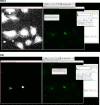Retention Using Selective Hooks (RUSH) Cargo Sorting Assay for Protein Vesicle Tracking in HeLa Cells
- PMID: 33796610
- PMCID: PMC8005885
- DOI: 10.21769/BioProtoc.3936
Retention Using Selective Hooks (RUSH) Cargo Sorting Assay for Protein Vesicle Tracking in HeLa Cells
Abstract
Monitoring vesicle trafficking is an excellent tool for the evaluation of protein dynamics in living cells. Such study is key for the understanding of protein sorting and secretion. Recent developments in microscopy, as well as new methodologies developed to study synchronized trafficking of proteins, allowed a better understanding of signaling, regulation and trafficking dynamics at the secretory pathway. One of the most helpful tools so far developed is the Retention Using Selective Hooks (RUSH) system, a methodology that facilitates the evaluation of synchronized cargo trafficking by monitoring fluorescent vesicles in cells upon biotin addition. Here we present a protocol that allows the quantitative evaluation of protein cargo trafficking at different fixed time points and an analytic approach that enables a better examination of specific cargo trafficking dynamics at the secretory pathway. Graphic abstract: Schematic representation of RUSH sorting assay in mammalian cells.
Keywords: Cargo sorting; Confocal microscopy; Protein trafficking; RUSH; Vesicle tracking.
Copyright © 2021 The Authors; exclusive licensee Bio-protocol LLC.
Conflict of interest statement
Competing interestsThe authors declare no competing financial interests.
Figures











Similar articles
-
Synchronized Visualization and Analysis of Intracellular Trafficking and Maturation of Orthoflavivirus Subviral Particles.Bio Protoc. 2025 May 20;15(10):e5324. doi: 10.21769/BioProtoc.5324. eCollection 2025 May 20. Bio Protoc. 2025. PMID: 40432757 Free PMC article.
-
Retention Using Selective Hooks (RUSH) Cargo Sorting Assay for Live-cell Vesicle Tracking in the Secretory Pathway Using HeLa Cells.Bio Protoc. 2021 Mar 20;11(6):e3958. doi: 10.21769/BioProtoc.3958. eCollection 2021 Mar 20. Bio Protoc. 2021. PMID: 33855118 Free PMC article.
-
Synchronization of secretory cargos trafficking in populations of cells.Methods Mol Biol. 2014;1174:211-23. doi: 10.1007/978-1-4939-0944-5_14. Methods Mol Biol. 2014. PMID: 24947384
-
Lipid-dependent coupling of secretory cargo sorting and trafficking at the trans-Golgi network.FEBS Lett. 2019 Sep;593(17):2412-2427. doi: 10.1002/1873-3468.13552. Epub 2019 Jul 30. FEBS Lett. 2019. PMID: 31344259 Free PMC article. Review.
-
Protein sorting receptors in the early secretory pathway.Annu Rev Biochem. 2010;79:777-802. doi: 10.1146/annurev-biochem-061608-091319. Annu Rev Biochem. 2010. PMID: 20533886 Review.
Cited by
-
Synchronized Visualization and Analysis of Intracellular Trafficking and Maturation of Orthoflavivirus Subviral Particles.Bio Protoc. 2025 May 20;15(10):e5324. doi: 10.21769/BioProtoc.5324. eCollection 2025 May 20. Bio Protoc. 2025. PMID: 40432757 Free PMC article.
-
METTL9 sustains vertebrate neural development primarily via non-catalytic functions.Nat Commun. 2025 Aug 1;16(1):7051. doi: 10.1038/s41467-025-62414-5. Nat Commun. 2025. PMID: 40745158 Free PMC article.
-
Rational design of small-molecule responsive protein switches.Protein Sci. 2023 Oct;32(10):e4774. doi: 10.1002/pro.4774. Protein Sci. 2023. PMID: 37656809 Free PMC article. Review.
-
Molecular mechanisms of endomembrane trafficking in plants.Plant Cell. 2022 Jan 20;34(1):146-173. doi: 10.1093/plcell/koab235. Plant Cell. 2022. PMID: 34550393 Free PMC article. Review.
References
-
- Boncompain G., Divoux S., Gareil N., de Forges H., Lescure A., Latreche L., Mercanti V., Jollivet F., Raposo G. and Perez F.(2012). Synchronization of secretory protein traffic in populations of cells. Nat Methods 9(5): 493-498. - PubMed
-
- Boncompain G. and Perez F.(2013). Fluorescence-based analysis of trafficking in mammalian cells. Methods Cell Biol 118: 179-194. - PubMed
-
- Boncompain G. and Weigel A. V.(2018). Transport and sorting in the Golgi complex: multiple mechanisms sort diverse cargo. Curr Opin Cell Biol 50: 94-101. - PubMed
-
- Crevenna A. H., Blank B., Maiser A., Emin D., Prescher J., Beck G., Kienzle C., Bartnik K., Habermann B., Pakdel M., Leonhardt H., Lamb D. C. and von Blume J.(2016). Secretory cargo sorting by Ca2+-dependent Cab45 oligomerization at the trans-Golgi network . J Cell Biol 213(3): 305-314. - PMC - PubMed
Grants and funding
LinkOut - more resources
Full Text Sources
Other Literature Sources
Research Materials

